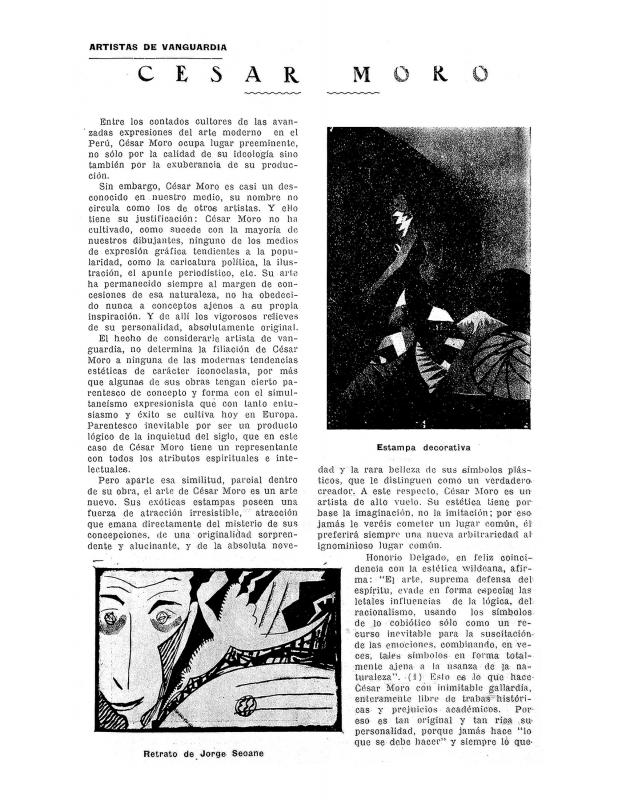The poet and visual artist César Moro (Alfredo Quízpez Asín) returned to Peru in late 1933, after spending eight years in Paris, where he was a member of the Surrealist movement. In May 1935, Moro and the Chilean artist María Valencia organized the first Surrealist exhibition ever held in Latin America (Sala Alcedo, Lima). The belligerent nature of the exhibited works stirred curiosity and debate among viewers because of their radical language, despite the limited press coverage of the event, a result of the rejection of conservative Peruvians. Also, everyone in Lima was distracted by the political discussions prompted by the murder of Mr. and Mrs. Miró Quesada Laos (the owners of the influential newspaper El Comercio) that same month. One of the few significant reviews appeared in Cascabel, the liberal weekly directed by Federico More (and his brothers Ernesto and Carlos). They had had been critical of the prevailing indigenist style and had promoted some of the local avant-garde’s work; they may also have met Moro in Europe (1926-28), where they were in touch with the European avant-garde. At about the same time that the Surrealist exhibition was held, Ernesto published a lengthy article about Moro’s work at the Museo Artístico del Hospital Mental de la Magdalena [Art Museum of the Magdalena Mental Hospital] (now Víctor Larco Herrera) and included the Peruvian poet’s comments in his campaign against José Sabogal’s role as director of the Escuela Nacional de Bellas Artes (ENBA). A year later, Moro’s solo exhibition was reviewed in Cascabel by R. T. (perhaps Ricardo Tenaud, who worked with Moro at the magazine El uso de la palabra in 1938). But the most extensive criticism came from Carlos Raygada, an influential local critic who was also a childhood friend of the poet’s. [See the following in the ICAA digital archive: “Artistas de vanguardia: César Moro” (doc. no. 1146756).] Previous comments notwithstanding, Moro’s visual art was still on the fringes of the local art scene, which was dominated by the nationalist rhetoric of indigenism. Like his compatriot César Vallejo, Moro’s leftist political views led him to organize a campaign on behalf of the Second Spanish Republic, an initiative considered subversive by the government of General Oscar Benavides. In 1938, following the first and only appearance of El uso de la palabra, Moro moved to Mexico, in self-imposed exile, where he played a key role in the organization of the International Surrealist Exhibition (1940).

